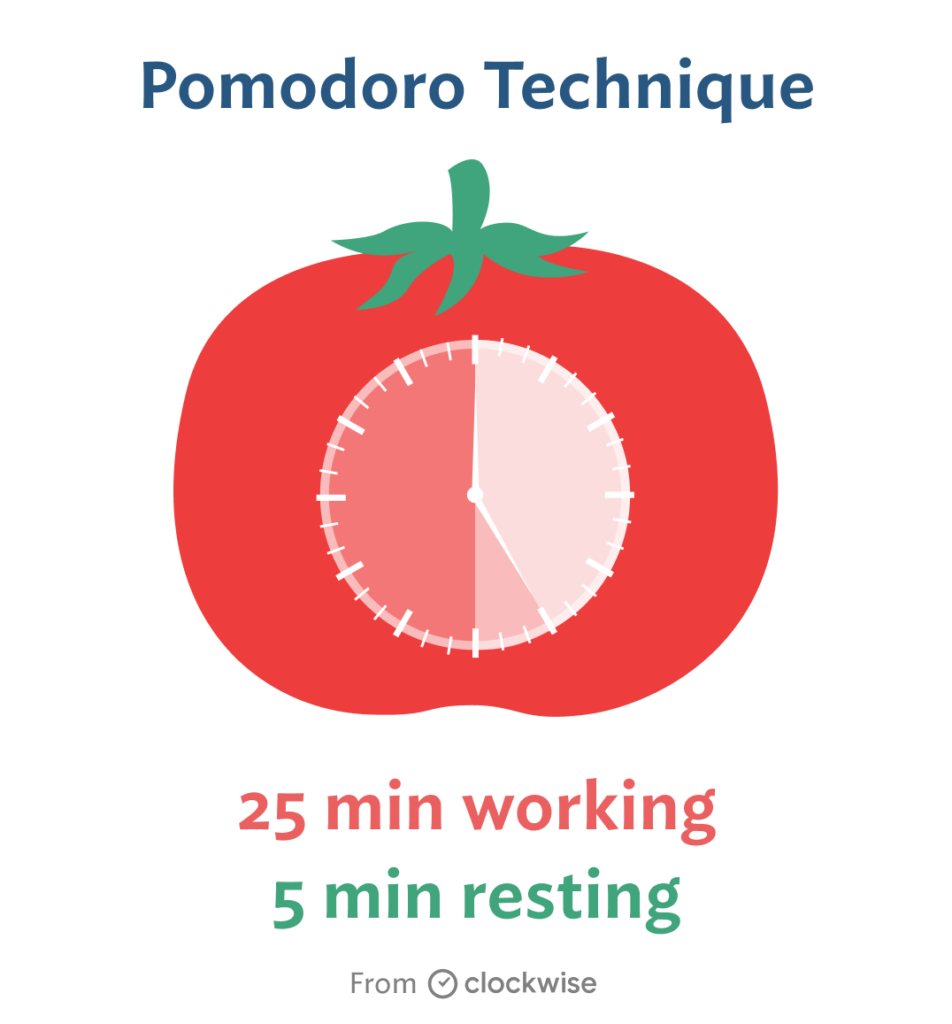What is the Pomodoro Technique?
Contents
Toggle
The Pomodoro Technique is a time management method conceived by Francesco Cirillo in the late 1980s and has stood the test of time, becoming a staple for individuals seeking to optimize productivity. The technique derives its name from the Italian word for tomato, inspired by a kitchen timer shaped like the fruit, which Cirillo used during his university years.
The basic premise of the Pomodoro Technique revolves around working in short, focused intervals—traditionally set at 25 minutes—known as “Pomodoros,” followed by a short break of 5 minutes. After completing four Pomodoros, a longer break of 15 to 30 minutes is taken to refresh and recharge. This systematic approach aims to reduce mental fatigue, maintain high levels of concentration, and ensure better time management.
The core philosophy behind the Pomodoro Technique is to enhance productivity and focus by segmenting tasks into manageable intervals, consequently combating procrastination. By doing so, individuals can maintain their attentiveness and motivation throughout the workday. Procrastination, often fueled by the daunting nature of extensive tasks, can be mitigated by breaking such tasks into smaller, more approachable segments.
Psychologically, the Pomodoro Technique leverages the concept of timeboxing, which provides a structured environment where the brain can work without distraction. The predefined breaks serve not only as incentives but also as essential periods for cognitive rest. This method encourages individuals to acknowledge their productivity cycles and adapt their work habits accordingly.
Furthermore, the technique’s periodic disruptions via scheduled breaks can significantly alleviate stress, reduce the risk of burnout, and sustain high-energy levels. By fostering a sense of accomplishment after each Pomodoro, individuals are more likely to experience enhanced motivation and a clearer focus on subsequent tasks.
Preparing for Your Pomodoro Sessions
Preparing adequately for your Pomodoro sessions is crucial for maximizing productivity and achieving your goals efficiently. The first step involves selecting and prioritizing tasks. Begin by creating a comprehensive to-do list or utilizing a task manager to categorize your responsibilities. This allows you to focus on the most important tasks, ensuring that you tackle high-priority items when your energy levels are at their peak.

Equipping yourself with the right tools is essential for a seamless Pomodoro session. A timer, whether digital or manual, is indispensable as it helps you adhere to the Pomodoro intervals. Numerous apps and online timers are available, offering features like automatic breaks and customizable session lengths. Additionally, maintaining a detailed to-do list facilitates better organization and keeps you on track.
Eliminating potential distractions is paramount to maintaining focus. Digital distractions, such as notifications and unnecessary tabs, should be minimized. Consider enabling ‘Do Not Disturb’ mode on your devices and using website blockers to prevent access to distracting sites. Physical distractions also require attention; setting up a quiet, clutter-free workspace can significantly enhance concentration. Ensure that all necessary materials and resources are within arm’s reach, reducing the need for interruptions during the session.
Setting clear, attainable goals for each Pomodoro session can further enhance productivity. Specific goals provide a sense of purpose and direction, enabling you to concentrate fully on the task at hand. Clearly defined objectives also allow for better progress tracking, as they provide benchmarks against which to measure your achievements. This not only fosters a sense of accomplishment but also aids in adjusting strategies for future sessions.
Executing the Pomodoro Technique
The Pomodoro Technique is a structured approach to time management, enabling individuals to enhance focus and productivity. Begin by selecting a task that you intend to complete. Set a timer for 25 minutes, known as one Pomodoro, and commit to dedicating this period of time solely to this single task. The key to effectiveness lies in working intensely, avoiding any interruptions or distractions.
Once the timer starts, immerse yourself fully in the task. Concentrated effort is essential, as it allows you to accomplish more in less time. If you find it challenging to ignore interruptions, consider strategies such as silencing your phone, closing unnecessary tabs on your browser, or finding a quiet workspace.
When the 25 minutes conclude, the timer will signal it is time for a break. Take a 5-minute break to rest and recharge. This short pause is crucial for maintaining high levels of productivity over extended periods. During these breaks, engage in activities that help you relax and reset your mind. Stretching, taking a short walk, or practicing deep breathing are excellent ways to rejuvenate. These activities not only provide a mental respite but also promote overall well-being.
After completing four Pomodoros, it is recommended to take a longer break of 15 to 30 minutes. This more extended break allows you to rest more thoroughly, further preventing burnout and maintaining sustained productivity throughout the day. Use this time to have a snack, meditate, or engage in a leisure activity that helps you unwind.
Common challenges can arise when executing the Pomodoro Technique, especially interruptions. When faced with unexpected distractions, jot down a quick note and address them after your current Pomodoro session ends. Communicating your focus mode to colleagues or family members can also help minimize disruptions. As you practice and fine-tune your approach, the ability to manage interruptions will improve, leading to more seamless work periods.
Customizing and Refining the Technique
The Pomodoro Technique is a highly adaptable productivity tool that can be customized to meet the unique needs of each user. While the standard intervals of 25 minutes of work followed by a 5-minute break are widely recommended, it’s important to recognize that individual productivity rhythms may vary. Some individuals might find that longer work intervals, such as 45 minutes, are more conducive to their focus, while others may benefit from shorter spurts of work, particularly if the tasks are more monotonous or physically demanding.
Adjusting the length of break intervals is equally important. For instance, those with mentally intensive tasks might need a longer recess to rejuvenate, whereas a brief pause might suffice after less demanding work. Experiment with different patterns, documenting how each adjustment affects your efficiency and levels of fatigue. By doing so, you can tailor the Pomodoro Technique to better suit your personal workflow.
Integrating other productivity tools and methods alongside the Pomodoro Technique can also enhance its effectiveness. Batching similar tasks together can streamline your focus, while the Eisenhower Matrix can help prioritize tasks by urgency and importance. Combining these strategies can lead to a more nuanced and effective approach to task management.
Monitoring progress is key to refining the technique. Tracking your accomplishments and reflecting on what worked or didn’t provides invaluable insights into your productivity. Use this feedback to make iterative improvements, ensuring that your methods continue to evolve with your needs.
Consistency is fundamental in building any habit, including mastering the Pomodoro Technique. To ensure sustainability, commit to regular practice and remain flexible with adaptations. By gradually ingraining this technique into your routine, you can harness its full potential to optimize productivity over time.


